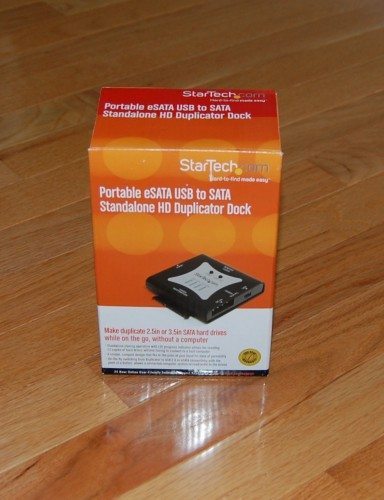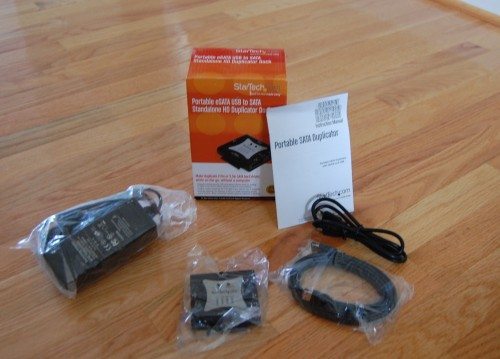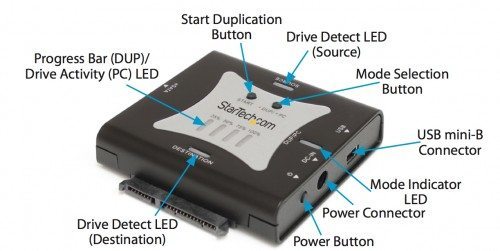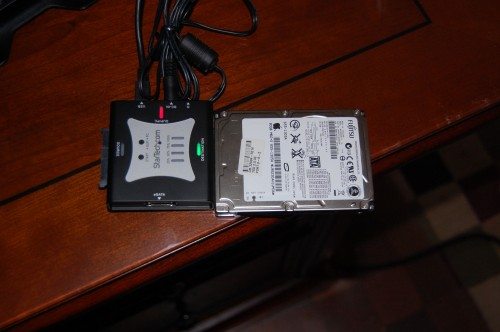 With the move to eSATA, many consumers are looking for a way to quickly and easily clone or move their content from their current SATA or IDE disk drive to a new eSATA drive, or they may be looking for a way to connect a new eSATA drive to a USB port for quick and easy access to data from another system. In either case, most of those looking to use this kind of product are professional techies within the IT Support Function of a company or service provider looking to deliver quick and easy service to their clients who want their important data moved between an old system and a new one, or have had a system failure and want quick access to recover their data. StarTech, the maker of many useful gadgets to connect everything from your home theater to your servers and USB devices, asked The Gadgeteer to review the StarTech Portable eSATA USB to SATA Standalone HDD Hard Drive Duplicator Dock. While I do not regularly need to clone disk drives, I do have the need to copy my trusty USB 500GB hard disk drive to a eSATA drive that I am installing in my kids’ PC so I have an online backup copy of my content. Read on to see how the product fared and if it ended up in my gadget graveyard or not.
With the move to eSATA, many consumers are looking for a way to quickly and easily clone or move their content from their current SATA or IDE disk drive to a new eSATA drive, or they may be looking for a way to connect a new eSATA drive to a USB port for quick and easy access to data from another system. In either case, most of those looking to use this kind of product are professional techies within the IT Support Function of a company or service provider looking to deliver quick and easy service to their clients who want their important data moved between an old system and a new one, or have had a system failure and want quick access to recover their data. StarTech, the maker of many useful gadgets to connect everything from your home theater to your servers and USB devices, asked The Gadgeteer to review the StarTech Portable eSATA USB to SATA Standalone HDD Hard Drive Duplicator Dock. While I do not regularly need to clone disk drives, I do have the need to copy my trusty USB 500GB hard disk drive to a eSATA drive that I am installing in my kids’ PC so I have an online backup copy of my content. Read on to see how the product fared and if it ended up in my gadget graveyard or not.
 I received the box and quickly opened it to find the following:
I received the box and quickly opened it to find the following:
- StarTech Portable eSATA USB to SATA Standalone HDD Hard Drive Duplicator Dock
- AC Power Supply for the StarTech Portable eSATA USB to SATA Standalone HDD Hard Drive Duplicator Dock Product Review
- USB to eSATA Cable
- Mini USB to USB Male Cable
- Product Manual written in several languages
The StarTech Portable eSATA USB to SATA Standalone HDD Hard Drive Duplicator Dock is tiny and easily fits in the palm of my hand. Weighing 1.59 oz (45G) and measuring in at a scant .64″ (16.3mm) high x 2.76″ (70mm) wide x 3.15″ (80mm) long it is easy to see how taking the product along for the ride would be simple.
 The Hard Drive Duplicator Dock is well labeled with ports for every hard disk drive interface that you can think of, save for SCSI, but no one really uses SCSI devices any longer. With that said, the weight of the product and size does not include the required power supply, which easily quadruples the weight. I would have thought that StarTech would have gone for a smaller cell phone style pop up AC prong charger to match the scant size of their Portable eSATA USB to SATA Standalone HDD Hard Drive Duplicator Dock, but then they would have had to pick a voltage and made two part numbers, one for the 240 folks, and another for the 110 folks. This way, they killed two birds with one AC Adapter, but gave up on the ultimate portability.
The Hard Drive Duplicator Dock is well labeled with ports for every hard disk drive interface that you can think of, save for SCSI, but no one really uses SCSI devices any longer. With that said, the weight of the product and size does not include the required power supply, which easily quadruples the weight. I would have thought that StarTech would have gone for a smaller cell phone style pop up AC prong charger to match the scant size of their Portable eSATA USB to SATA Standalone HDD Hard Drive Duplicator Dock, but then they would have had to pick a voltage and made two part numbers, one for the 240 folks, and another for the 110 folks. This way, they killed two birds with one AC Adapter, but gave up on the ultimate portability.
 I used the StarTech Portable eSATA USB to SATA Standalone HDD Hard Drive Duplicator Dock to duplicate one of my USB hard disk drives to a new eSATA drive that I planned to install in a PC that my kids are using. To use the device, one simply connects the AC power and the source and target hard disk drives to the correct ports on the Hard Drive Duplicator Dock and presses a button and the cloning magically happens. The process can be monitored by looking at the progress bar LEDs that are broken into four 25% segments. Depending on your drive size and drive characteristics, the cloning process can take anywhere from 30 minutes to a few hours for larger drives and those with slower interfaces. When I cloned my drive, a 500GB disk drive it took a bit under two hours. The drives were connected via USB and the eSATA connections. From my review of the clone drive, it was a perfect copy of the original – there were no issues with the files nor directory structure of the cloned drive. I used the Drive Duplicator to connect the eSATA drive to my laptop via USB, as the dock enables one to use an eSATA drive through USB in a slave mode. I tried a number of drives and the device was a bit finicky on which drives it would connect to, but after a bit of fiddling with the connection and powering the device off and on I was able to see the drives.
I used the StarTech Portable eSATA USB to SATA Standalone HDD Hard Drive Duplicator Dock to duplicate one of my USB hard disk drives to a new eSATA drive that I planned to install in a PC that my kids are using. To use the device, one simply connects the AC power and the source and target hard disk drives to the correct ports on the Hard Drive Duplicator Dock and presses a button and the cloning magically happens. The process can be monitored by looking at the progress bar LEDs that are broken into four 25% segments. Depending on your drive size and drive characteristics, the cloning process can take anywhere from 30 minutes to a few hours for larger drives and those with slower interfaces. When I cloned my drive, a 500GB disk drive it took a bit under two hours. The drives were connected via USB and the eSATA connections. From my review of the clone drive, it was a perfect copy of the original – there were no issues with the files nor directory structure of the cloned drive. I used the Drive Duplicator to connect the eSATA drive to my laptop via USB, as the dock enables one to use an eSATA drive through USB in a slave mode. I tried a number of drives and the device was a bit finicky on which drives it would connect to, but after a bit of fiddling with the connection and powering the device off and on I was able to see the drives.
The Portable eSATA USB to SATA Standalone HDD Hard Drive Duplicator Dock can also be used as a slave device to allow you to connect your USB, SATA, or eSATA devices to your PC or Mac to browse the contents of a disk drive. To change the mode of the device, one simply presses the Mode Selection Button and the color changes to show you that the mode has been switched. I should add that the device also shows that source, target, and slave devices have been successfully recognized by changing colors on the LEDs. This is important as you need a visual “OK” to show you that you are ready to go. The Slave Mode is a very useful feature as I was able to connect my PC drive to my Mac without the use of a drive enclosure. For a professional techie or service technician this capability is invaluable as one can show up at a job site and access any disk drive type simply and easily. As we all know, or should know, when you have a system failure, the first thing that you do is worry about your precious data and many of us do not backup our data as we should. Being able to connect up any disk drive type to your laptop and check that the information is ok is worth the $75 asking price alone. Having drive cloning capability on top of that is an added benefit along with the size and portability of the StarTech Portable eSATA USB to SATA Standalone HDD Hard Drive Duplicator Dock.
To sum up the review, I would happily recommend the StarTech Portable eSATA USB to SATA Standalone HDD Hard Drive Duplicator Dock for any professional techie or service technician that needs to quickly and easily clone or access the contents of a disk drive. The Portable eSATA USB to SATA Standalone HDD Hard Drive Duplicator Dock is available on the StarTech website as well as your favorite gadget retailers for around $75. The StarTech Portable eSATA USB to SATA Standalone HDD Hard Drive Duplicator Dock will live on, perhaps not in daily use, but at least a couple of times a year.
Trullypine Laptop Cooling Pad with 12 Quiet Fans, Slim Portable for 12-17.3 Inch Laptop Cooler Stand with 5 Height Adjustable, Ergonomic Gaming Cooling Fan Pad with Two USB Ports & Phone Holder (Gear)
$20.19 (as of December 6, 2025 18:03 GMT -05:00 - More infoProduct prices and availability are accurate as of the date/time indicated and are subject to change. Any price and availability information displayed on [relevant Amazon Site(s), as applicable] at the time of purchase will apply to the purchase of this product.)Compressed air Duster,4 Gear Adjustable 100000RPM Electric air Duster, Cordless air Blower for Laptop, Keyboard, Electronics, Replaces Compressed Air Can
15% OffProduct Information
| Price: | $74.99 |
| Manufacturer: | StarTech |
| Retailer: | StarTech |
| Requirements: |
|
| Pros: |
|
| Cons: |
|



Gadgeteer Comment Policy - Please read before commenting
I have owned several of these devices. I keep one or two in my truck/laptop kit at all times. I very often end up doing data recovery onsite with failed computers/servers/etc. These things are worth their weight in gold. Paired with the right software on my recovery laptop, I often can plug in a few of these into a server and rebuild Raid Arrays, and rescue critical data in a few hours, vs several days.
I only have one problem with these units. Most of the units that have a harddrive duplication button, will NOT properly duplicate file systems that are not FAT32 or NTFS. They also do not properly duplicate many boot records. Do not rely on one of these to create a “bare metal” backup, that you can just pop in and run. If you do TEST the drive first. However for external drives and data drives they work very well.
ALWAYS TEST your backups. Way too often I run into someone who thinks they have been doing backups religiously, only to find they arn’t getting the backup they think they are getting.